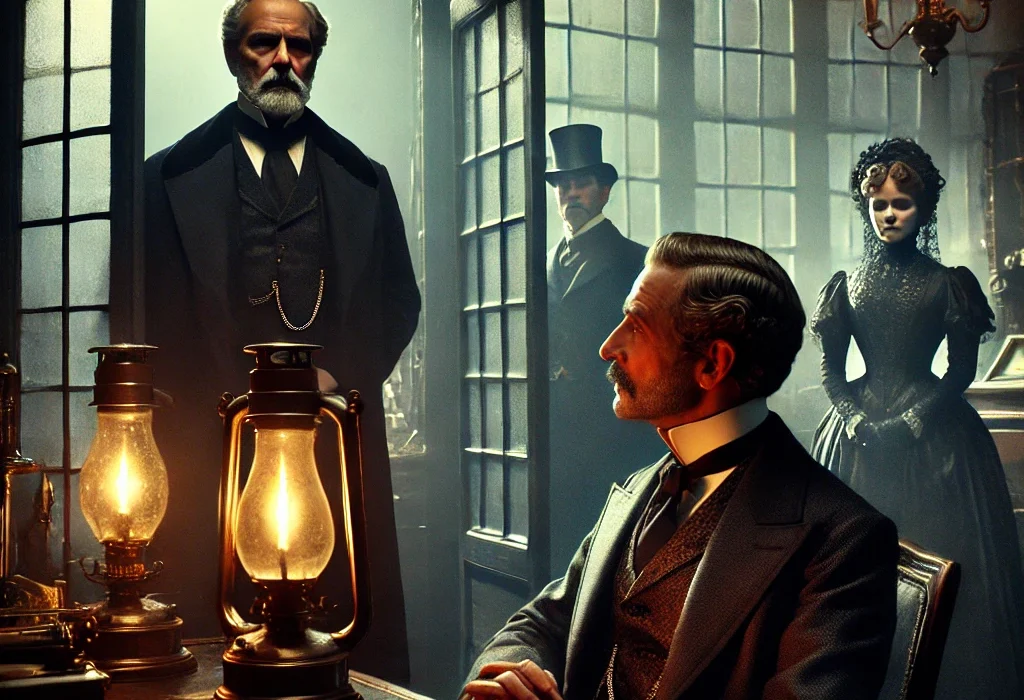“Hunted Down,” a short story by Charles Dickens, was first published in 1859. It showcases Dickens’ talent for mystery and detective fiction. The narrative is set against the backdrop of Victorian society, revolving around themes of deception, retribution, and the pursuit of justice. The story unfolds through the perspective of Mr. Sampson, the Chief Manager of a Life Assurance Office, who recounts his chilling encounter with the enigmatic and sinister Mr. Julius Slinkton.
Comprehensive Plot Summary
Mr. Sampson, a retired Chief Manager of a Life Assurance Office, reflects on his many curious encounters over the years, emphasizing the significance of physiognomy, the study of facial expressions and mannerisms. His narrative begins with the unsettling figure of Julius Slinkton, whom he first notices through the glass partition of his office. Slinkton, impeccably dressed and in mourning, requests some forms for a life insurance policy. Despite Slinkton’s courteous demeanor, Sampson feels an inexplicable aversion to him, sensing a sinister undercurrent.
Shortly after, Sampson encounters Slinkton at a friend’s dinner party. Slinkton charms the guests with his eloquence and knowledge, speaking of a recent personal loss—the death of one of his beloved nieces. His story elicits sympathy, but Sampson’s distrust deepens. Slinkton’s polished exterior hides something dark and deceptive, a feeling that Sampson cannot shake.
Slinkton’s involvement in life insurance becomes more intricate when he mentions a friend, Alfred Beckwith, who intends to secure a policy. Beckwith, supposedly living on the same staircase as Slinkton, nominates him as a reference. Despite the apparent legitimacy, Sampson’s unease grows, and he senses that Slinkton is manipulating the situation for his gain.
Months later, Sampson travels to Scarborough for a respite by the sea. There, he meets Slinkton again, this time accompanied by his delicate and sorrowful niece, Miss Niner. The interaction reveals more about Slinkton’s manipulative nature. Miss Niner confides in Sampson about an old gentleman, referred to as her “shadow,” who seems to follow her everywhere. This shadow, Major Banks, later communicates privately with Sampson, hinting at deeper layers of deceit and danger surrounding Slinkton.
As Sampson delves deeper, he discovers the nefarious plot orchestrated by Slinkton. Slinkton had previously deceived and poisoned another young woman, leading to her untimely death. He is now attempting to replicate this crime with Miss Niner, securing a life insurance policy in her name to benefit financially from her demise. Sampson realizes the urgency of the situation and resolves to protect Miss Niner from her uncle’s malevolent scheme.
The climax occurs in a dramatic confrontation in the Temple, where Slinkton and Beckwith reside. Beckwith, who has been pretending to be a drunkard, reveals his true intentions and accuses Slinkton of murder and forgery. He discloses that he and Sampson have been aware of Slinkton’s plot and have been meticulously countering it. Beckwith’s transformation from a seemingly helpless victim to a determined avenger shocks Slinkton to his core.
Beckwith’s revelations are damning. He details how he has been observing Slinkton’s every move, even as Slinkton believed him to be an incapacitated drunkard. Beckwith recounts how he manipulated the situation to gain Slinkton’s trust, only to gather evidence of his crimes. Slinkton’s calm facade cracks as he realizes the extent of Beckwith’s surveillance and the meticulous planning behind it.
In the final confrontation, Beckwith exposes Slinkton’s crimes, revealing that he has been documenting every detail of Slinkton’s murderous plot. The villain, cornered and desperate, attempts to escape justice by ingesting poison. His death is swift, and he collapses in a grotesque spasm, marking the fitting end of his sinister life. Beckwith’s mission to avenge the innocent girl and protect Miss Niner is fulfilled, but the toll of his relentless pursuit is evident. The weight of his actions and the loss of the woman he loved have left him broken-hearted.
Despite his victory, Beckwith is a shattered man. He confides in Sampson, expressing his profound sorrow and regret. He reveals that his sole purpose in life was to avenge the innocent and destroy Slinkton. With that purpose fulfilled, he feels adrift and bereft of any reason to continue living. His health declines rapidly, and he dies early the following spring, leaving everything he had to Miss Niner’s surviving sister.
Miss Niner, now free from her uncle’s malevolent influence, goes on to live a happy life. She marries Sampson’s nephew, who succeeds Beckwith in his professional duties. Their children bring joy to Sampson’s life, often playing in his garden, a symbol of the peace and happiness that finally prevailed after such dark and turbulent times.
The story is a testament to the relentless pursuit of justice, the power of observation, and the ultimate triumph of good over evil. Mr. Sampson’s keen insights and Beckwith’s unwavering determination ensure that Slinkton’s malevolent schemes are thwarted, and justice is served. The narrative ends on a note of hope and redemption, with the innocent protected and the guilty punished.
Main Characters
- Mr. Sampson: The Chief Manager of a Life Assurance Office, narrator of the story, and a keen observer of human nature. His instincts and persistence uncover Slinkton’s malevolent schemes.
- Julius Slinkton: The antagonist, a deceitful and manipulative man who seeks to profit from the deaths of his victims through life insurance fraud. His charming exterior hides a sinister intent.
- Miss Niner: Slinkton’s niece, a delicate and melancholy young woman who becomes the target of his murderous plot. Her vulnerability contrasts sharply with Slinkton’s malevolence.
- Mr. Alfred Beckwith: Initially appearing as a degraded drunkard, Beckwith reveals himself to be a determined avenger of his beloved’s death, orchestrated by Slinkton.
Themes and Motifs
- Deception and Disguise: The story explores the theme of deception, with characters like Slinkton and Beckwith hiding their true intentions behind false personas.
- Justice and Retribution: The pursuit of justice is central to the narrative, with Beckwith’s relentless quest to expose Slinkton’s crimes and protect the innocent.
- The Power of Observation: Mr. Sampson’s ability to read faces and discern true character plays a crucial role in unraveling the mystery and thwarting Slinkton’s plans.
Writing Style and Tone
Charles Dickens employs a narrative style rich in detail and psychological insight. His use of first-person narration through Mr. Sampson allows for a deep exploration of character motivations and inner thoughts. The tone oscillates between suspenseful and reflective, capturing the eerie atmosphere of the mystery and the moral undertones of the story. Dickens’ characteristic wit and social commentary are also evident, adding layers of meaning to the plot and characters. His prose, marked by vivid descriptions and sharp dialogue, immerses the reader in the Victorian setting and the intricate dynamics of the narrative.
If this summary has sparked your interest, we would appreciate you subscribing to our newsletter.
There’s a treasure trove of other fascinating book summaries waiting for you. Check out our collection of stories that inspire, thrill, and provoke thought, just like this one by clicking here.
If you want to request a book summary, click here.
When Saurabh is not working/watching movies/reading books/traveling, you can reach him via Twitter/X, or LinkedIn.
Restart reading!






